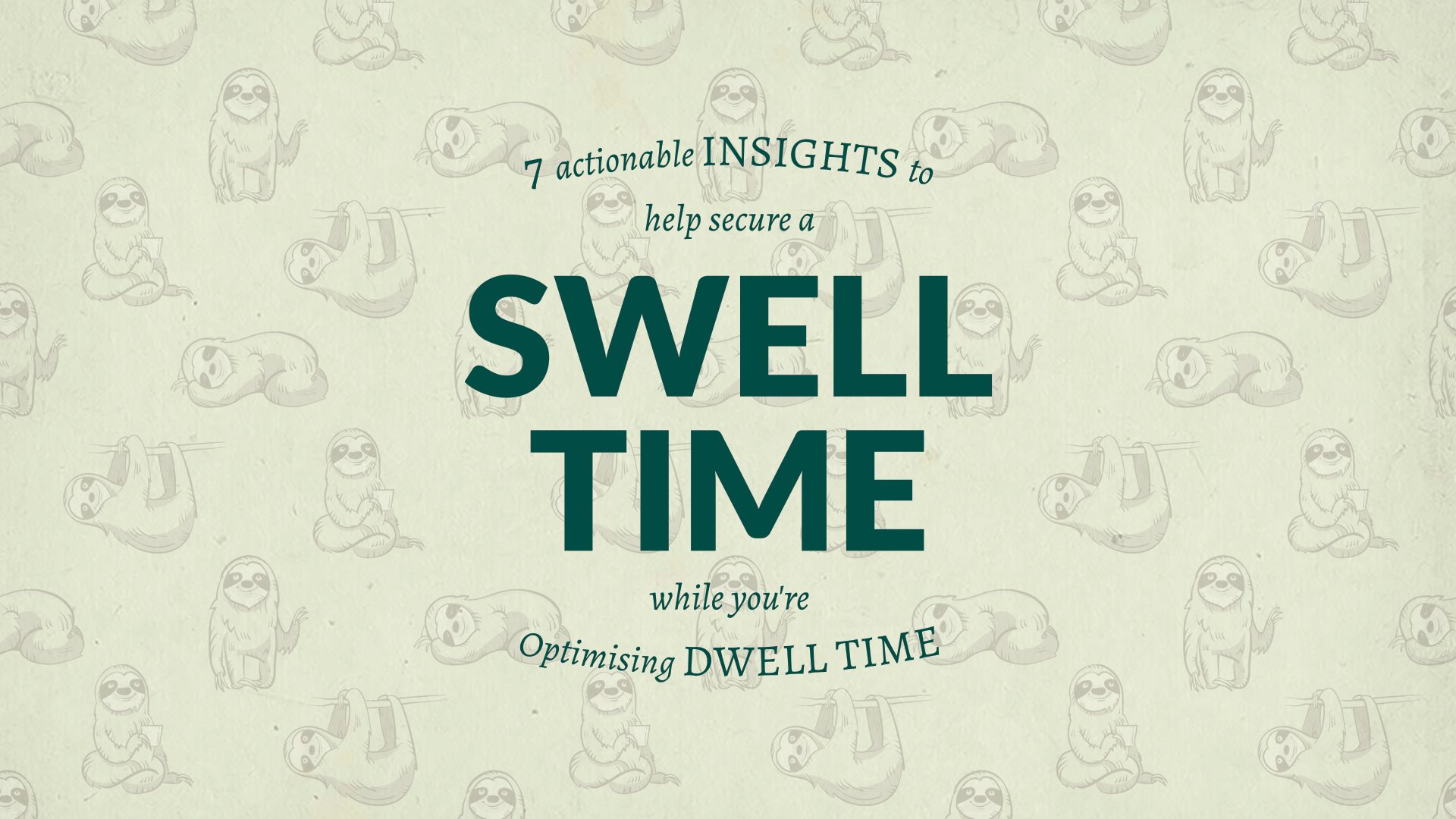TIME IS PRECIOUS
approx 8 minute read
Congratulations! Your website placed ‘runner-up’ in a relevance contest.
Oh, you didn’t notice? Don’t worry. Contests like these happen billions of times every day, behind the scenes. And no one pays attention, really. Apart from the odd search engine algorithm.
One of the things search overlords use to rank this contest is ‘Dwell time’.
Let’s look at how improving yours could give your website a boost.
Dwell time
You might have heard this term thrown around when you’ve been looking to optimise your website. Maybe you’ve been told that if you want to improve your position on Google, you’ll need to improve your dwell time.
But what does it actually mean, why does it matter and how would you make sure yours is doing well?
What is dwell time?
Dwell time is the length of time a person spends looking at a webpage after they’ve clicked a link from the search engine results page (SERP). It measures the length of time they linger on a page before they decide to click back to the results page that they came from.
It’s important to differentiate between ‘dwell time’, ‘bounce rate‘, and ‘time on page’ here. While they all sound like they could be measuring the same thing, they’re actually very different metrics.
Dwell time is NOT how long someone spends on your page before they exit the page or switch to another. Nor is it the time someone spends on your page after they’ve clicked through a link on social media or an ad.
This metric specifically refers to the time someone spends looking at your page before returning to the SERPs.
Rapidly bouncing back and forth from the search results to a website, then back to the results, then another website is a phenomenon known as Pogo Sticking.
Why does dwell time matter?
Dwell time is a great indicator to understand whether a webpage is correctly satisfying the reason why the user was searching for the page in the first place.
A shorter dwell time can indicate that the user’s query was not fully satisfied after viewing the page. Whereas a long dwell time can indicate the user’s query intent was adequately satisfied because it suggests they’ve hung around on the page long enough to get the information they needed.
You’ve probably experienced this yourself. If you’ve ever searched for something, been disappointed by the first result you clicked on, and resorted back to the results page two seconds later – you would’ve contributed to a short dwell time on a webpage. Pogo Sticker!
So, it matters because it’s a good indication that your site is serving its users.
Will a good dwell time affect my ranking?
There’s been no official statement on whether dwell time is a definite factor in the way that search engines like Google will rank your page. Nonetheless, dwell time is widely believed to play a role in rankings.
This is because, back in 2017, the head of Google’s artificial intelligence initiative, Google Brian, said this:
“Google is now integrating machine learning into [the process of figuring out what the relationship between a search and the best page for that search is]. So then training models on when someone clicks on a page and stays on that page, when they go back, or when they are trying to figure out exactly that relationship.”
So it does look like dwell time could influence things. Plus, other search engines like Bing have said they definitely consider dwell time in their rankings. That’s why it’s a good metric to get to grips with.
How do you calculate your dwell time?
There’s no direct way to calculate your dwell time. That being said, there are ways to get a pretty good idea of your average dwell time on your site.
One way of doing this is through the popular tool Google Analytics:
- Login to Google Analytics – pretty straightforward so far!
- Then click on “behaviour”,
- Next click on “site content”,
- Then on “landing pages”,
- Create a “new segment” and make sure you’ve clicked that you want to only view “organic traffic”,
- And… you’re done! You’ll now be able to see your “average session duration” which will give you a good indication of the amount of time a user is spending on your site.
What’s a good dwell time?
Generally speaking, we would want to see a dwell time on a site of around two to four minutes. This would give a user ample time to find the information they’re looking for and the fact they’ve lingered for a while suggests that the information they received was enough for them.
This isn’t a golden rule, however. All web pages serve different purposes and answer different queries so it’s hard to give a definitive answer. This is especially true when we consider the world of SEO is constantly adapting and changing, meaning that pinning down an answer is never as easy as we wish it was.
For example, let’s say someone was looking for a phone number on your site so they can make a reservation. A short dwell time in this instance is probably not a bad thing. It might just mean that your site is easy to navigate, meaning a user can do exactly what they need pretty quickly.
That being said, if you’re a DIY site offering people long-form information on how to build a bookshelf, for example, someone hanging around for a couple of seconds on the page is probably not a good thing.
Always relate it back to the purpose your page is trying to serve.
How do you improve your dwell time?
Okay, now we know what dwell time is, why it matters, and all the little caveats involved in understanding it, let’s leap into different ways we could improve our dwell time.
#1 Produce engaging content
When someone first arrives on your page, it’s important to grab their attention quickly, or the user may click out to see if there are better sites for their topic. One good way of doing this is by producing high-quality content.
By high-quality content, we mean content that is accessible, useful, and entertaining.
#2 Make your content easy to engage with
Once you’ve made great content, you need to make sure that it’s easy to engage with. You can do this by adding share links to blog posts or online content. This might take the form of a little Twitter or Instagram icon at the bottom of an article so people can share if they found it useful.
#3 Improve your user experience
This can be realised in several different ways. One easy way, for example, would be to make sure your content is nicely split up so there are no dense and unreadable blocks or text. Alternatively, you can make sure that the page design is visually appealing while still being fairly simple to navigate.
This way the user can see where the content is and what the page contains easily so they can achieve exactly what they wanted to do when they first clicked on your page.
#4 Make your page mobile-friendly
Following on from the above point about good user experience: one sure-fire way to make sure users aren’t jumping shipping after a couple of seconds is to make sure your page works on mobile devices.
#5 Use multimedia content on your webpages
Many readers might get tired of reading too much text, so consider breaking up the page by embedding videos, podcasts, images, and other multimedia elements to keep your readers engaged.
#6 Use internal links
Internal links are just links to other pages on your site. They’re a brilliant way to keep users on your site for longer as they’re invited to click around and explore. It works because you’re directing visitors to the content they may also want to read thus increasing the likelihood that visitors will view more than one page on your website.
The key is ensuring your links are relevant to the topic at hand. A blog post about social media, for instance, should link to other posts about Instagram or YouTube — not website development. This reduces bounce rate, increases dwell time, and increases overall engagement on your webpage – lovely!
#7 Keep your page speedy
It’s no secret that people online are impatient. 47% of people expect a web page to load in 2 seconds or less so if your page takes forever to load, then people are going to click away before they read the first word. Additionally, once readers are scrolling, if they find elements on the page like pictures or videos that aren’t loading properly, they might choose to abandon the page.
That’s why you want to make sure that your important web pages are quick to load.
Don’t dwell on it!
Dwell time is certainly a metric that can help improve your site but don’t make the mistake of over-emphasising it. There are plenty of other ranking factors out there that are probably a little more important for you to work on. If your page is loading slowly, if your website isn’t mobile-friendly – these are all factors that you might want to prioritise before you start looking at dwell time.
We can help you with all of this, though. We’re your local SEO experts. We’re there for you, on the high street and in your community.
Drop-in, give us a call or send us an email and we’ll promptly respond. Let’s get together and see about increasing your online presence.






